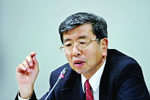
ADB for investment in infrastructure projects
Special Correspondent | Monday, 16 June 2014

Visiting Asian Development Bank President Takehiko Nakao has laid emphasis on significantly increasing the investment-GDP ratio for infrastructure projects by steadily strengthening the revenue collection as it is very important to support the country's socio-economic development.
At a press conference held at the ADB office in the capital Sunday, he shared his views with the media following his meetings with Prime Minister Sheikh Hasina and Finance Minister AMA Muhith at their respective offices.
ADB Director General for Central and West Asia Department Juan Miranda and its country director Kazuhiko Higuchi among others spoke on the occasion.
Mr Nakao said his discussions with the Prime Minister and the Finance Minister centered on continuation of the four decades of partnership between Bangladesh and ADB, adding that the multilateral agency had so far given a total of $15.03 billion to Bangladesh and its development assistance was flowing at an average rate of one billion a year.
Mr Nakao praised Bangladesh for achieving a strong macro-economic growth supported by steady poverty reduction and success in other areas of development. He said 6 per cent GDP growth in the outgoing fiscal and the fall of the poverty level from 56 per cent in 1991 to 31.5 per cent in 2010 -- a drop of more than 25 per cent in two decades, was a highly commendable job.
Bangladesh should, however, raise its investment in infrastructure projects from the current level of 3 per cent of the GDP, which was far lower than many other countries of the region, to up to 15 per cent. It should also encourage public-private partnership (PPP) projects for infrastructure development.
It would give the necessary boost, he said, for the economy along with skill development through more vocational training and improvement of the business climate.
He said ADB would continue to assist Bangladesh's efforts to address infrastructure needs including power, gas, roads, railways and urban services along with development of secondary education and vocational training. ADB would also strengthen support to regional connectivity and energy trade while continuing to support investments in agriculture to enhance rural productivity and rural jobs and income.
Mr Nakao laid emphasis on shortening project approval procedures and their implementation process. He said, "ADB is also trying to improve its own internal process to accelerate procurement and project management, as well as delegating more authority to resident missions including the one in Dhaka."
He said the lending agency was attaching importance to PPP projects and so far helped to set up a PPP desk at the Prime Minister's office. The agency would also set up a PPP office now at its Bangladesh Mission, he said.
He said the development potential of the country was immense. "The country enjoyed stability and security in the past years better than many others in the region. The security position is stable here for investment."
He further said Bangladesh had a very strong private sector, NGOs were playing a role in development. Working condition of workers was also improving despite last year's tragedy in the garment sector.
He said he visited several projects and was scheduled to visit some more ADB-funded projects Monday including Sirajganj power plant, Bangabandhu Bridge and a madrasha in the district.
To a question as to how the ADP takes a new proposal of the Chinese government to set up an Asian Infrastructure Bank and Bangladesh government's interest to join it, Mr Nakao said ADB was also making significant contributions to infrastructure development in the region. "We are doing our best," he said adding the multilateral agency would however cooperate if the step was taken to set up it.
To another question about Padma Bridge which is going to be without any ADB loan, he said: "I want to see the project become a reality; it will deliver far reaching benefits to the nation and to the region."